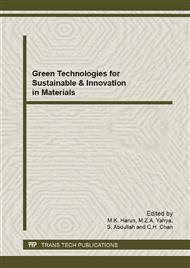[1]
Eriksson M, Bergman F, Jacobson S. On the nature of tribological contact in automotive brakes. Wear 2002; 252 (1-2): 26-36.
DOI: 10.1016/s0043-1648(01)00849-3
Google Scholar
[2]
Lu Y. A combinatorial approach for automotive friction materials: Effects of ingredients on friction performance. Compos Sci and Tech 2006; 66: 591–598.
DOI: 10.1016/j.compscitech.2005.05.032
Google Scholar
[3]
Cho MH, Kim SJ, Kim D, Jang H. Effects of ingredients on tribological characteristics of a brake lining: an experimental case study. Wear 2005; 258: 1682–1687.
DOI: 10.1016/j.wear.2004.11.021
Google Scholar
[4]
Mutlu I, Eldogan O, Findik F. Tribological properties of some phenolic composites suggested for automotive brakes. Tribol Int 2006; 39: 317–325.
DOI: 10.1016/j.triboint.2005.02.002
Google Scholar
[5]
Jang H, Ko K, Kim SJ, Basch RH, Fash JW. The effect of metal fibers on the friction performance of automotive brake friction materials. Wear 2004; 256: 406–414.
DOI: 10.1016/s0043-1648(03)00445-9
Google Scholar
[6]
Chan D, Stachowiak GW. Review of automotive brake friction materials. J Auto Eng 2001; 201: 953-966.
Google Scholar
[7]
Chan D, Stachowiak GW. Review of automotive brake friction materials. J Auto Eng 2001; 201: 953-966.
Google Scholar
[8]
Basfar AA, Abdel-Aziz MM, Mofti S. Influence of different curing systems on the physico-mechanical properties and stability of SBR and NR rubbers. Radiat Phys Chem 2000; 63: 81–87.
DOI: 10.1016/s0969-806x(01)00486-8
Google Scholar
[9]
Nakason C, Wannavilai P, Kaesaman A. Effect of vulcanization system on properties of thermoplastic vulcanizates based on epoxidized natural rubber/ polypropylene blends. Polym Test 2006; 25: 34–41.
DOI: 10.1016/j.polymertesting.2005.09.007
Google Scholar
[10]
Bik J, Guszewskib W, Rzymskia WM, Zagorski ZP. EB radiation crosslinking of elastomers. Radiat Phys Chem 2003; 67 (3): 421-423.
Google Scholar
[11]
Zhao W, You L, Zhong X, Youefang Z, Sun J. Radiation vulcanization of hydrogenated acrylonitrile butadiene rubber (HNBR). J Appl Polym Sci 1994; 54 (9): 1199-1205.
DOI: 10.1002/app.1994.070540902
Google Scholar
[12]
Oproiu C, Martin D, Toma M, Marghitu S, Jianu A, Transitory and permanent effects of electron beam irradiation on insulating materials, Nucl Instr and Meth B 2000; 669: 166–167.
DOI: 10.1016/s0168-583x(99)00871-x
Google Scholar
[13]
Yasin T, Ahmad S, Ahmad M, Yoshii F. Effect of concentration of polyfunctional monomers on physical properties of acrylonitrile– butadiene rubber under electron-beam irradiation. Radiat Phys Chem 2005; 73: 155-158.
DOI: 10.1016/j.radphyschem.2004.07.009
Google Scholar
[14]
Banik I, Bhowmick AK. Influence of electron beam irradiation on the mechanical properties and crosslinking of fluorocarbon elastomer. Radiat Phys Chem 1999; 54: 135-142.
DOI: 10.1016/s0969-806x(98)00218-7
Google Scholar
[15]
Chantara Thevy R, Nasir M, Baharin A, Zaman K. Electron beam irradiation of epoxidized natural rubber. Nucl Instr and Meth B 2000; 171: 455-464.
DOI: 10.1016/s0168-583x(00)00301-3
Google Scholar
[16]
Martin D, Ighigeanu D, Mateescu E, Craciun G, Ighigeanu A. Vulcanization of rubber mixtures by simultaneous electron beam and microwave irradiation. Radiat Phys Chem 2002; 65(1): 63-65.
DOI: 10.1016/s0969-806x(01)00680-6
Google Scholar
[17]
Coran AY. Vulcanization. In: Mark, J.E., Erman, B., Eirich, F.R. (Eds. ), Science and Technology of Rubber. New York: Academic Press, (1994).
Google Scholar
[18]
Basfar AA, Silverman J. Improved ozone resistance of styrene–butadiene rubber cured by a combination of sulfur and ionizing radiation. Polym Degrad Stab 1994; 46(1): 1–8.
DOI: 10.1016/0141-3910(94)90101-5
Google Scholar
[19]
Datta SK, Bhowmick AK, Chaki TK, Majali AB, Despande RS. Electron beam initiated modification of ethylene vinyl acetate using trimethylolpropane trimethacrylate. Polymer 1996; 37: 45–55.
DOI: 10.1016/0032-3861(96)81598-9
Google Scholar
[20]
Banik I, Bhowmick AK. Influences of electron beam radiation on the mechanical properties and crosslinking of fluorocarbon elastomer. Radiat Phys Chem 1999; 54: 135–142.
DOI: 10.1016/s0969-806x(98)00218-7
Google Scholar
[21]
Ahmed S, Basfar AA, Abdel Aziz MM. Comparison of thermal stability of sulfur, peroxide and radiation cured NBR and SBR vulcanizates. Polym Degrad Stab 2006; 67: 319-323.
DOI: 10.1016/s0141-3910(99)00133-0
Google Scholar


